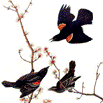Wildlife Damage Management, Internet Center for
Document Type
Article
Date of this Version
November 1976
Abstract
Some of the problems that have been publicized for the past two to three years about blackbirds and Starlings in the southeastern United States are concerned with what these birds eat and the degree to which these granivores compete on their wintering grounds. The assumption by agriculturists has been that these birds cause severe depredations. Futhermore it is presumed by some that food supplies are unlimited and that these birds are simply living off the “fat of the land”; others consider that food is limited and that the birds are “pressured” into direct competition with man's food or food destined for livestock. Sadly, there is little information about either case, and to date media reports have been based upon unsupported allegations. In order to put the overall problem of these birds1 feeding in the winter ecosystems into perspective, this paper introduces certain aspects of well-known and widely accepted ecological theory into the assessment of food habits of these birds. Despite unpublished comments made by U.S. Fish and Wildlife Service Animal Depredations Control personnel in the past, we know little about diet of blackbirds and Starlings in terms of broad ecological associations. There indeed is considerable information about what the birds eat, mainly from ad hoc surveys taken from time to time in the latter part of the last century and through this century; but to date no one has attempted to synthesize this information and make predictions about the ecology of these animals. Thus little can be said about these birds in terms of responsible management.


